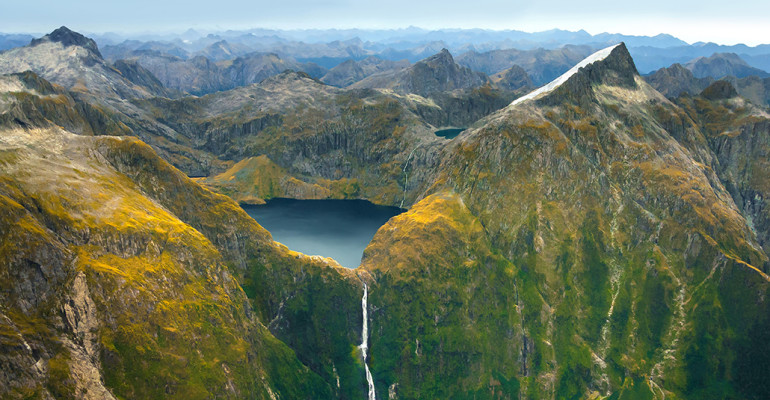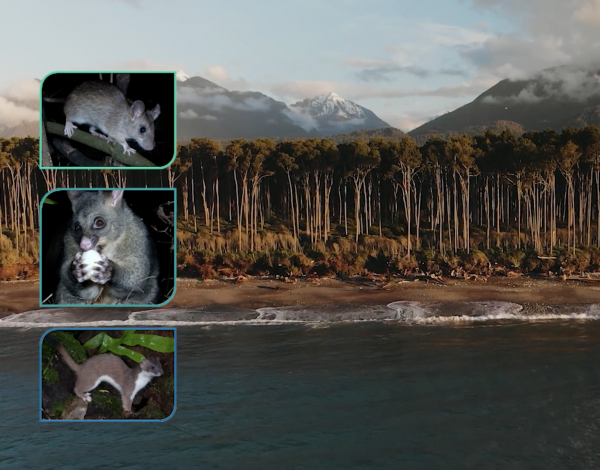Biosecurity research to develop smart connected robots that seek out Aotearoa’s last predators
1 October 2021 | Read time: 7 minutes

A critical part of eradicating pests and predators is finding the last few before numbers increase again. In Aotearoa this currently involves skilled trappers flown in by helicopter to traverse huge rugged landscapes. This is resource heavy and difficult, but critical to a predator free New Zealand.
The Science for Technological Innovation (SfTI) National Science Challenge launches its Biosecurity Technology Spearhead Research project this week to develop new technology to support this key part of our Aotearoa-wide mission to eradicate NZ predators and pests by 2050.
SfTI’s Biosecurity Technology Spearhead research project has been funded $2 million over two years, and will be hosted at the University of Auckland (UoA) and co-led by Dr Katerina Taškova from the UoA Machine Learning Group and Dr Tara Strand from Scion.
Predator 2050: A crazy and ambitious goal
In 2016, when former Prime Minister John Key set the goal of Predator Free 2050, he put the annual cost of predators to Aotearoa’s economy at $3.3 billion.
Project Co-lead, Tara Strand, explains how, on top of this cost to the economy, there is also the cost of eradication methods going forward.
“The cost of eradication has been estimated at $9.04 billion using current methods Which is people and helicopters. Even a 10% reduction of these costs would have a huge impact for Aotearoa,” she said.

“This push for a predator free 2050 is a crazy and ambitious goal. This is New Zealand’s moon shot. The scale is massive, and to achieve this we need to develop new technologies and fast,” she said.
Detecting NZ’s last predators. Down to the last one
SfTI’s Biosecurity Research Project Proposal was developed by a team, including Katerina Taškova and Tara Strand. This team was drawn from a large cross disciplinary group from across Aotearoa, who took part in a series of workshops to identify the area of Biosecurity Technology where this project could have the most potential impact.
“We wanted to identify what area of Biosecurity would make the best use of cutting edge STEM. We focussed on the fact that to eradicate, you must find all predators. Down to zero. Zero is of huge importance in predator management,” said Tara Strand.
“One impregnated female stoat can start an entirely new population. We need to be confident in our zeros and we could see the huge potential to build on current sensor technology and smart robotics to detect these final predators with more confidence and efficiency,” she said.
The workshops held in collaboration with the Biological Heritage | Ngā Koiora Tuku Iho National Science Challenge National Science Challenge, were part of a wider Mission design process which identified a very clear focus for the research proposal. The team has called this: Detecting the last predator.
Smart robots that can see, hear, smell, communicate and learn
In order to identify small populations of predators in vast areas, the technology needs to have advanced capabilities across several areas.
This research will develop and test a group of smart networked sensors that use their collective intelligence to decide if each individual sensor is in the right location to observe a predator. With the help of Artificial Intelligence (AI) algorithms (models) designed to learn as they detect, the sensor network will be able to seek out the last predators in huge areas with increasing efficiency using multiple sensing technologies. These technologies may include thermal cameras, stereo colour cameras, microphones and electronic noses.
“As well as detect the predators, these robots have to be able to move in complex terrain, without damage to the environment. We need them to conserve energy and communicate with each other. Plus we want them to ultimately biodegrade,” said Tara Strand.
“Developing this technology will not only be game changing for our predator free goals here in NZ, but may create an international market offering,” she said.
Co-designing Artificial Intelligence which incorporates Mātauranga Māori
Throughout the mission design process mātauranga Māori has informed the development of the research project. Te Tira Whakamātaki Operations Manager and member of the Biological Heritage National Science Challenge Leadership team, Tame Malcolm (Te Arawa: Ngāti Tarāwhai, Ngāti Pikiao, Ngāti Ngararanui, Tapuika, Ngāti Whakaue, Ngāti Ruanui), who took part in the mission design and will also be part of an advisory panel to oversee the project going forward, outlined how important it is to approach this project within the wider context of Aotearoa:
“It’s a bit more holistic and aligned with te ao Māori views and values to look at it as a whole big picture - rather than just biosecurity,” he said.
The project will include a series of wānanga to explore the best way to embed rohe-specific tohu or data (area specific knowledge from local iwi) into the design of the robots, the way they look as well as how they work.
“It’s important that these robots are acceptable to communities where they will be operating,” said SfTI Vision Mātauranga Theme leader, Dr Katharina Ruckstuhl (Ngāi Tahu, Rangitāne).
“The wānanga will explore how mātauranga can inform the development of the robots, the ethics and protocols around their use and also the implications for Artificial Intelligence. This will be done in accordance with some of the latest thinking in Māori and Indigenous data sovereignty,” she said.
A team New Zealand approach to Biosecurity Technology
Co-lead Katerina Taškova explains how she feels this large scale project is bringing together a unique blend of expertise across disciplines that will place New Zealand at the forefront of Biosecurity Technology development:
“Identifying and developing this research proposal has been a journey. But at every turn we have been reassured that we are going in the right direction. There is a gap and a need for this technology - modular, sustainable and adaptive real-time predators surveillance system, with capacity to learn and plan from data and knowledge and operate autonomously to a large extent. There is a lot happening in this very dynamic and rapidly advancing space, but everything points towards a merging of efforts in this particular focus area.”
“Bringing a transdisciplinary team to develop this technology including early-to-mid career researchers like myself, and students, I believe is creating a new space of expert collaboration which could bring New Zealand to the very cutting edge of this global issue,” she said.